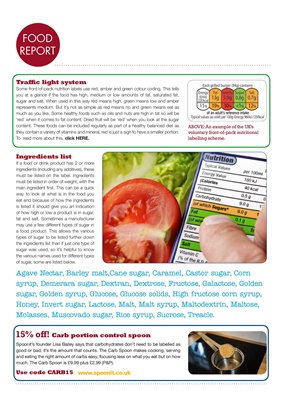
KIT
www.spoonit.co.ukissue 30
MAGAZINE
DESANG
PLUS • New Products • Groovy giveaways • News (for T1 and T2)
WE'RE NO
ANGELS
But business as usual is best for
diabetics at Christmas
MAKING
CARBS COUNT:
CHESTNUTS ROASTING
ON OPEN FIRES
Our magazine is free!
Sign up here! email address
FOOD CLAIMS ON LABELS
Since 2007 rules have been put in place
to stop misleading claims. Claims must
now be approved by the European
commission and follow strict guidelines.
Light or lite
To say that a food is 'light' or 'lite', it must
be at least 30% lower in fat or sugar than
standard products. Sometimes you'll find
that a 'light version of one brand contains
the same amount of fat or sugar as the
standard version of another brand. The
best way to compare products is to look at
the information per 100g. 'Light' products
can also be surprising high in fat or sugar,
as light just means 30% less, not low.
Low fat / low sugar
A claim that a food is low in fat may
only be made where the food contains
no more than 3g of fat per 100g. Low
sugar can only be used if a product has
less that 5g of sugar per 100g. A claim
such as this can make a product appear
a healthy alternative and in some cases
that is true. However it's always worth
checking the label to compare the rest
of the information in the nutritional panel
because some products that are low in
fat will have a higher sugar content.
No added sugar
This means that the food hasn't had
sugar added to it as an ingredient. A
food that has "no added sugar" can
still contain sugar but it will come
from ingredients that contain naturally
occurring sugars such as fruit or milk.
No added sugar muesli which contains
dried fruit is a good example.
Traffic light system
Some front-of-pack nutrition labels use
red, amber and green colour coding. This
tells you at a glance if the food has high,
medium or low amounts of fat, saturated
fat, sugar and salt.
When used in this way red means
high, green means low and amber
represents medium. But it's not as simple
as red means no and green means eat
as much as you like. Some healthy foods
such as oils and nuts are high in fat so
will be 'red' when it comes to fat content.
Dried fruit will be 'red' when you look at
the sugar content. These foods can be
included regularly as part of a healthy
balanced diet as they contain a variety of
vitamins and mineral, red is just a sign that
a smaller portion is needed.
FOOD
REPORT
Use code CARB15 at checkout
Spoonit's founder Lisa Bailey says that
carbohydrates don't need to be labelled as
good or bad, it's the amount that counts.
The Carb Spoon makes cooking, serving
and eating the right amount of carbs easy,
focusing less on what people eat but
concentrating more on how much. With
every Carb Spoon you receive a quick
guide and booklet detailing everything you
need to know about using it. The Carb
Spoon is £9.99 plus £2.99 (P&P).
15% off!
Easy carb control
An example of the UK's voluntary
front of pack nutritional labelling
scheme. To read more, click HERE.